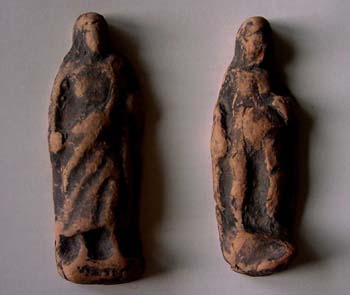 |
|
Terracotta, 2nd century AD, locality Naples Region
|
The medicine of the Romans was not very powerful. All the more important, therefore, was the help that gods could give to the sick. Votive offerings are consecration gifts with the help of which one tried - and still tries to make gods gracious. The most varied materials were used: clay, terra cotta, bronze, wrought iron, silver, brass sheet, wax.
Already in the Hallstatt time one knew victim figures. Very numerous are the finds from Etruscan times. In cult wells, especially near thermal springs and sources of large rivers (such as Tiber), they were found by the thousands.
From the Mediterranean region, the replicas of the diseased body parts come - so-called "identification gifts": In many cases one finds a toad as a toad, in the ancient world the symbol for the uterus.especially common are tablets depicting eyes, bites, hearts, arms and legs, phalluses, breasts, infants, vulvae. The objects reflect a lack of knowledge of the anatomical conditions - it is believed that the Etruscan manufacturers were mostly animal organs of sheep and cattle as models. In addition to terracotta, which represent individual body parts, there are whole-body representations, all objects mostly of poor quality.
Votive figures were extremely common at the time of the Roman Republic (4th-1 st century BC) to disappear without replacement - the reasons for the sudden decline of this form of the cult are unclear.
The two 8 cm high Roman votive figures presented here come from the region of Naples, where they were found in a veritable votive offering factory by the thousands. Apparently these Roman manufactures (2nd century AD) are on the one hand a pregnant woman (on the right), on the other hand they are a simple, nonspecific female figure who could be used polyvalently for a wide variety of gynecological problems ...
|